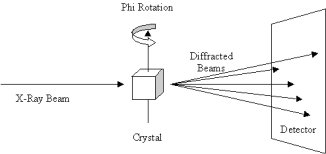
Eppley Institute for Cancer Research
University of Nebraska Medical Center
| Home | - | Introduction | - | CommonTasks | - | Index | - | About |
 |
Eppley Institute for Cancer Research |
||||||||
|
University of Nebraska Medical Center |
|||||||||
|
BEAM-ish works with a specific set of images. The set images is fairly simple to collect. The setup for an experiment that BEAM-ish will process the results from is shown below:

The X-Ray beam must have some specific conditions. First it must be parallel. Second it must be monochromatic. Third it should be very intense. These conditions are necessary to minimize the beam effects that will be measured at the detector from the mosaicity effects we are actually trying to measure. The more intense the beam the quicker frames can be collected and the less likely a beam dump will occur during the experiment. Currently, these conditions can only be obtained at a synchrotron source where the beam line is operating in unfocused mode.
Mechanically the goniometer should be capable of very small accurate movements in phi. Depending on the available equipment the limiting factor for the phi slice will probably be due to how accurate the mechanics of the goniometer are. It may be necessary to have the equipment modified to use phi steps on the order of 0.001 degrees.
Currently, BEAM-ish only supports the ADSC image format. These detectors are available at nearly all synchrotron facilities. Depending on the length of the exposure it may be possible to collect the data in dezinger mode. This method is preferred but zingers can be removed after collection during the profile analysis done by PEAKSTATS.
Once the above conditions have been met it is time to determine how the data will be collected. BEAM-ish uses a course image to determine the crystal orientation and to detect were reflection profiles need to be measured. Typically several 1 degree course images will be acquired until a reasonable area of the crystal has been identified. This area should contain a lot of intense reflections. Several 1 degree images should be exposed around this area to generate a well refined orientation matrix. Within the area overlapped by the 1 degree images a fine phi collection can be carried out. Due to limitations within HALFSLICE the total number of frames in the fine phi sequence cannot be more than 1000 labeled 000 to 999.
All of the images need to be collected with the same detector settings. The most common would be to collect in either high resolution mode or 2x2 binned mode. In either case the coarse and fine images must be collected the same way. The exposure times do not have to be the same between coarse and fine. Usually coarse images will be collected with much higher exposure times.